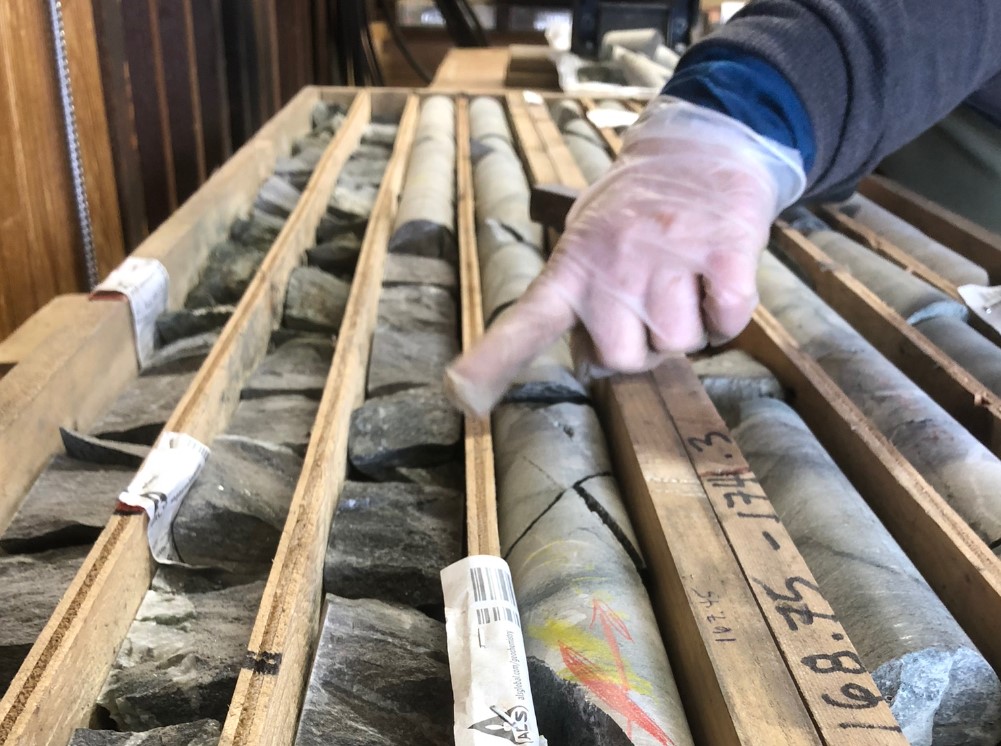Golden Cariboo drilling Quesnelle gold quartz mine property, British Columbia

Golden Cariboo Resources Ltd. [CSE-GCC; OTC-GCCFF] provided a summary of drilling to date, following a review and evaluation of the intercepts at its Quesnelle gold quartz mine property near Hixon, British Columbia.
A total of 4,144.4 metres in 15 diamond drill holes have been completed on three separate zones since commencement of drilling on the property by the company. Six holes (QGQ22-02, QGQ22-03, QGQ23-04, QGQ24-05, QGQ24-06 and QGQ24-07) were drilled to test the Main zone in the vicinity of the historical workings dating from 1866 to 1939. The best results were obtained drilling to the southeast, perpendicular to previous drilling of 2,201 metres in 13 holes conducted between 1983 and 2008; the latter drilling targeted the northwest-trending andesite/metaclastic sedimentary contact.
Phase 1 drilling has been completed and the drill crew is on break, after which phase 2 will commence. Drilling equipment remains on site.
Consequently, QGQ23-04 intersected a broad zone of pyritic fault-hosted mineralization, below the historical gold-bearing Koch vein in underground workings, returning 1.35 g/t gold over 41.0 metres (134.5 feet), including 4.65 g/t gold over 7.15 metres (23.5 feet) and 1.12 g/t gold over 18.7 metres (61.4 feet) 30 metres to the south of the intercept of 0.69 g/t gold over 22.3 metres (73.2 feet) obtained in QGQ22-02. A zone of quartz-carbonate veinlets was encountered below the pyritic fault mineralization in QGQ23-04, yielding 2.77 grams per tonne gold over 6.25 metres.
Three holes (QGQ22-01, QGQ24-08 and QGQ24-09) were drilled on the North Hixon zone, initially targeting the company’s 2019 discovery of magnetite-pyrite bearing float, which yielded 9.8 g/t gold. Although the source was not intersected, the hole did intersect zones of pyritic fault mineralization and quartz-carbonate veinlets; the latter is associated with dominantly sericite-pyrite-plus-or-minus-silica altered metaclastic sedimentary rocks within broad zones of ankerite alteration, proximal to the contact with andesitic tuffs.
Results included 0.87 g/t gold over 32.0 metres, ending in mineralization, in QGQ22-01; and 0.58 g/t gold over 61.4 metres and 0.43 g/t gold over 89.7 metres, including 0.99 g/t gold over 24.6 metres, all within an anomalous zone of 0.29 g/t gold over 263.1 metres in QGQ22-8.
Visible gold was identified associated with sphalerite in QGQ22-8. The zone was interpreted to trend 135 degrees/70 degrees southwest, resulting in true widths of approximately 50%, but true width is not definitively known. There is an extreme paucity of outcrop throughout the property area and initial difficulties were encountered drilling oriented core.
The Halo zone, discovered by the company 830 metres northwest of the Main zone in late 2022, returned 1.01 g/t gold to 5.08 g/t gold from a six-metre-deep trench from four grab samples of a strongly limonitic fault zone with minor quartz-carbonate. The Halo zone was targeted by six holes (QGQ24-10 to QGQ24-15), with the three more westerly directed holes intersecting quartz-carbonate veinlets with visible gold below the fault zone, dominantly hosted by sericite-pyrite-fuchsite-plus-or-minus-silica altered andesitic flows within broad zones of ankerite alteration, similar to that encountered at and probably representing a subparallel zone to the North Hixon zone.
If the zone trends similarly to that at North Hixon, the true widths at the Halo zone are possibly 50-70% of the downhole lengths. Minor sphalerite (commonly associated with the visible gold), minor chalcopyrite and trace galena have been noted within the veins. Logging has been completed and sampling is still in progress. Results are pending. Mineralization and alteration encountered, show strong similarities to the Main zone, from which the best intercepts were drilled southeasterly (at 90-134 degrees to the Halo drill holes).
A preliminary analysis of the intercepts indicates major, probable first-order, northwest-trending faults, which commonly follow lithological contacts. Northeast vein trends have been recognized at the Main zone and southeast-directed holes were successful in intersecting mineralization. Based on this and the interpreted orogenic style of the mineralization, in which second-order structures are generally associated with mineralization, the main mineralized structures are thought to strike northeasterly.
Consequently, drilling is currently planned to target the southeast strike extent of the Halo zone from the west to intersect it perpendicular to the overall trend using an oriented core system.
Following this, drilling will also be conducted with southeast-directed holes to target the second-order structures. Good potential exists over the 830 metres toward the Main zone as well as to the northwest of the Halo and to the southeast of the Main zone, none of which have been previously drilled.
Golden Cariboo Resources is rediscovering the Cariboo gold rush by proceeding with highly targeted drilling and trenching programs on its Quesnelle gold quartz mine property, which is almost fully encircled on three of four sides by Osisko Development.
Golden Cariboo’s Quesnelle gold quartz mine property is 4 km northeast of and road accessible from Hixon in central British Columbia. The project includes the Quesnelle quartz gold-silver deposit, which was discovered in 1865 in conjunction with placer mining activities. Hixon Creek, which dissects the old workings, is a placer creek that has seen small-scale placer production since the mid-1860s.
